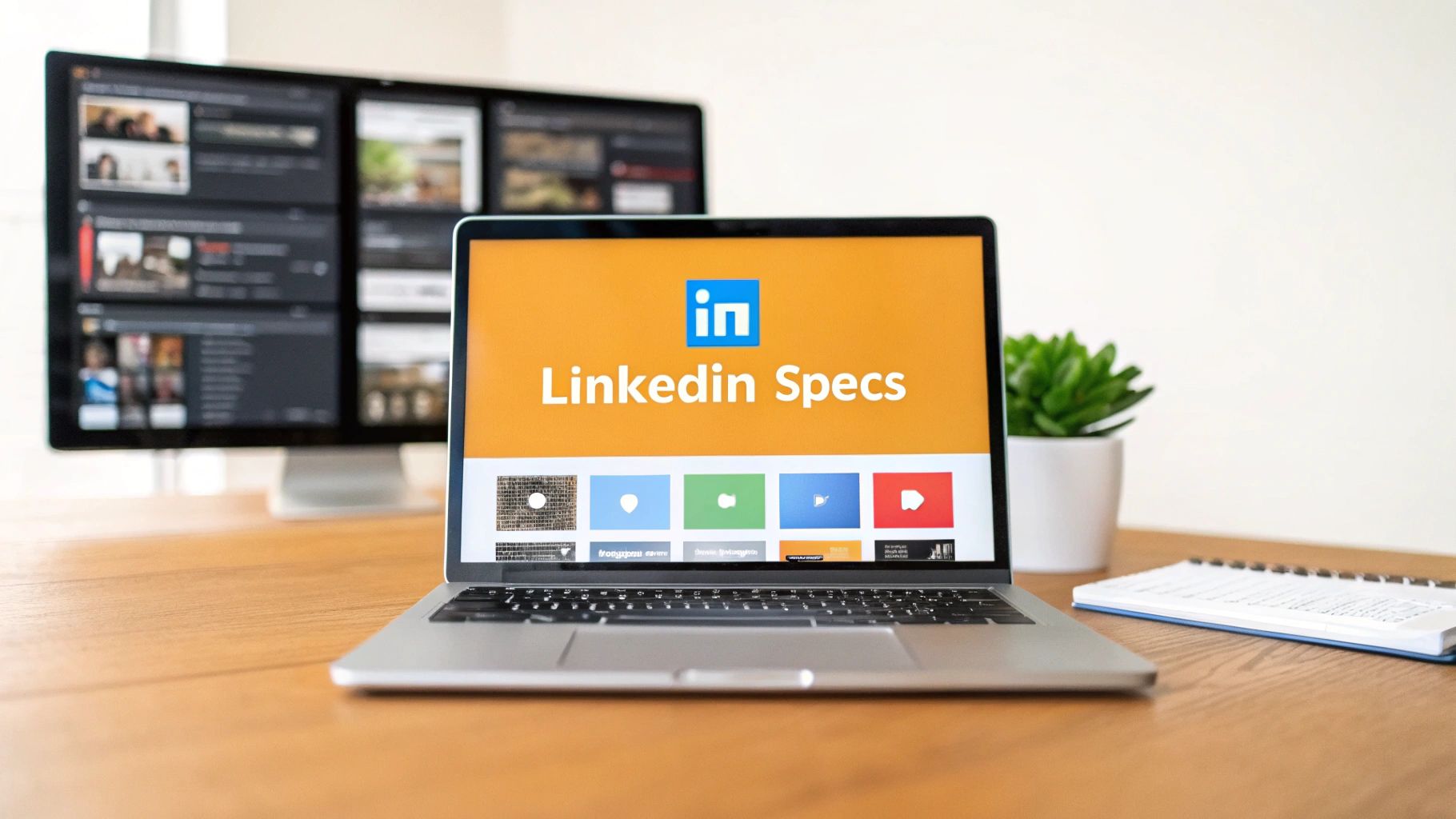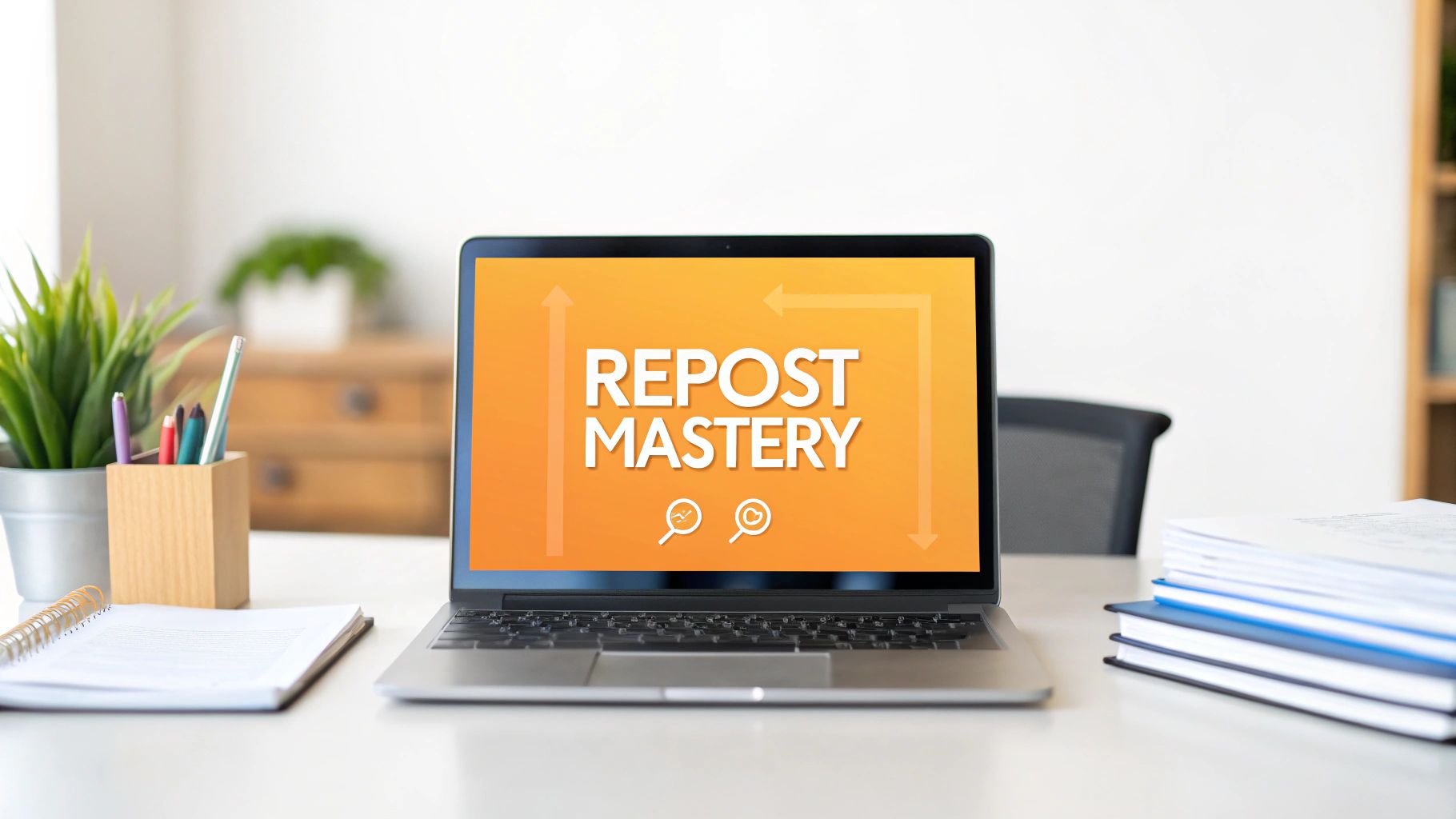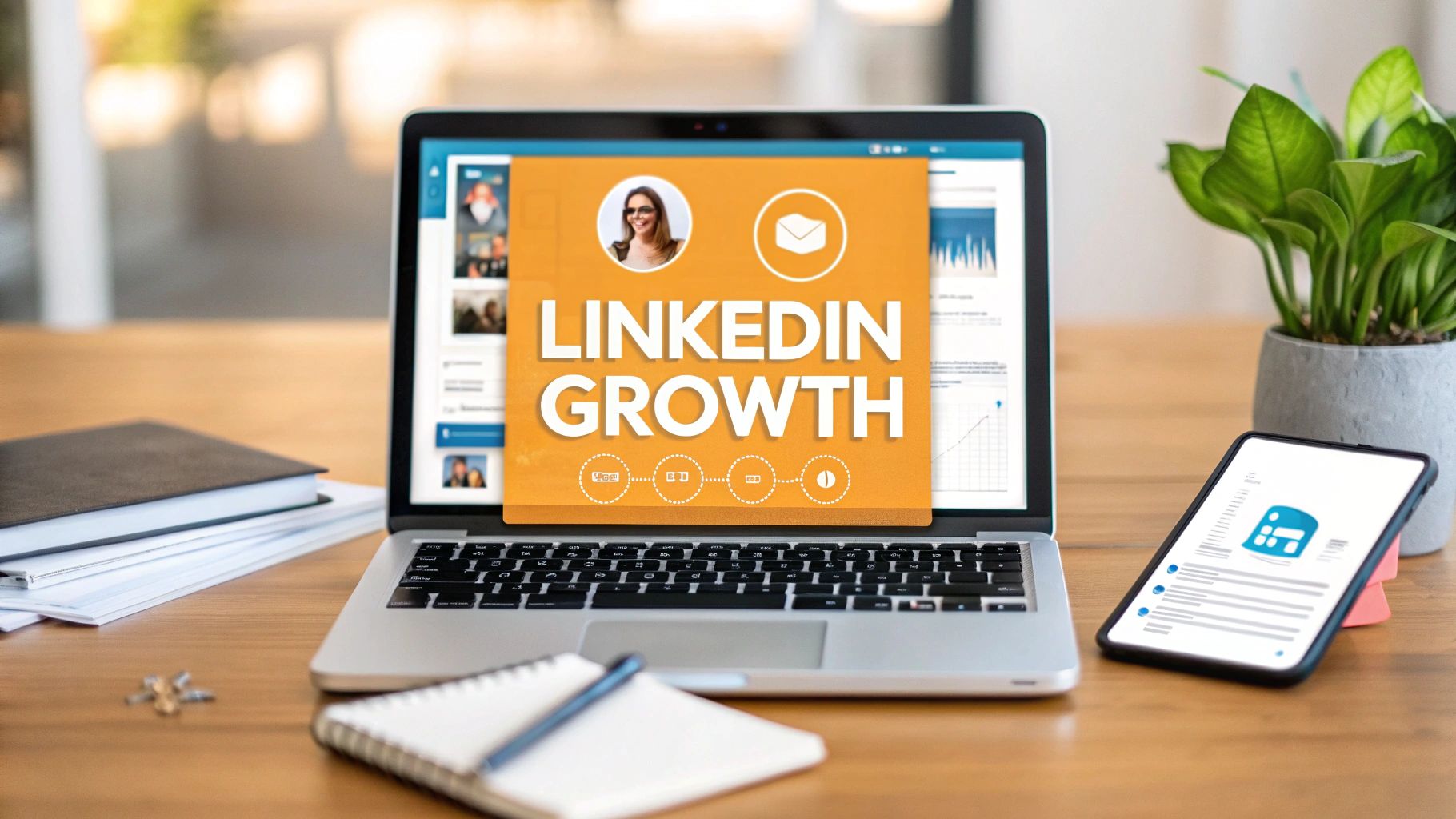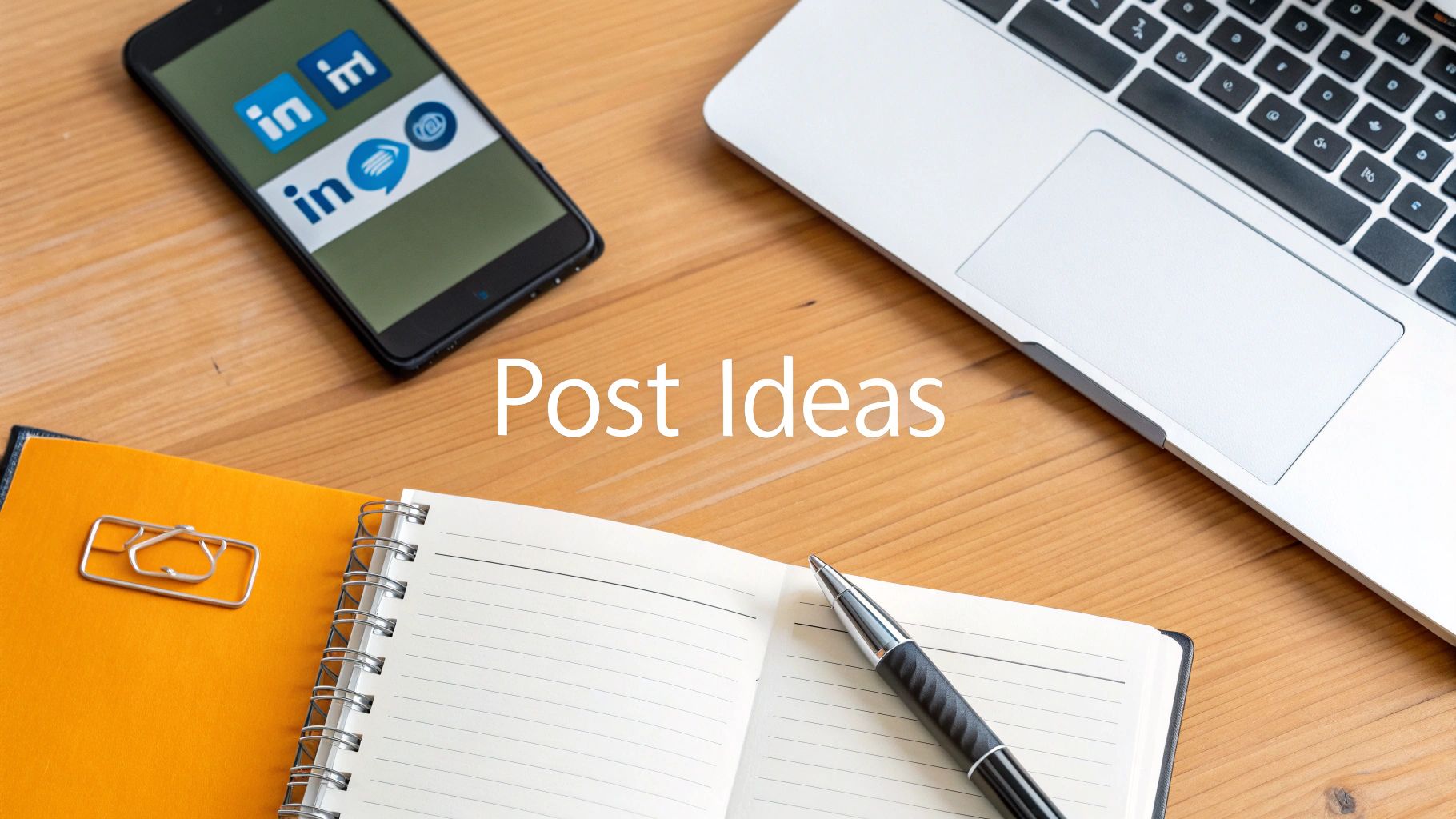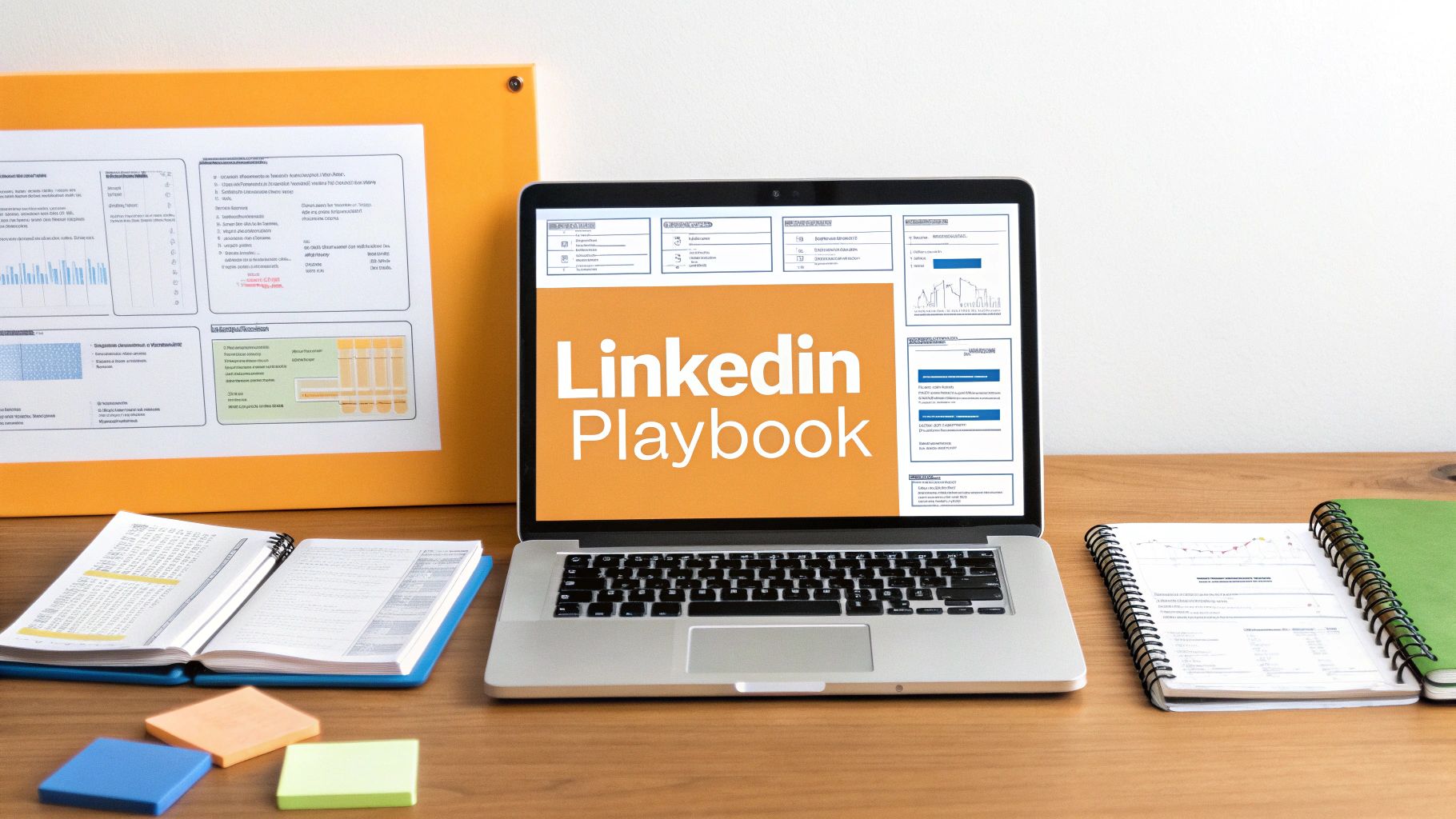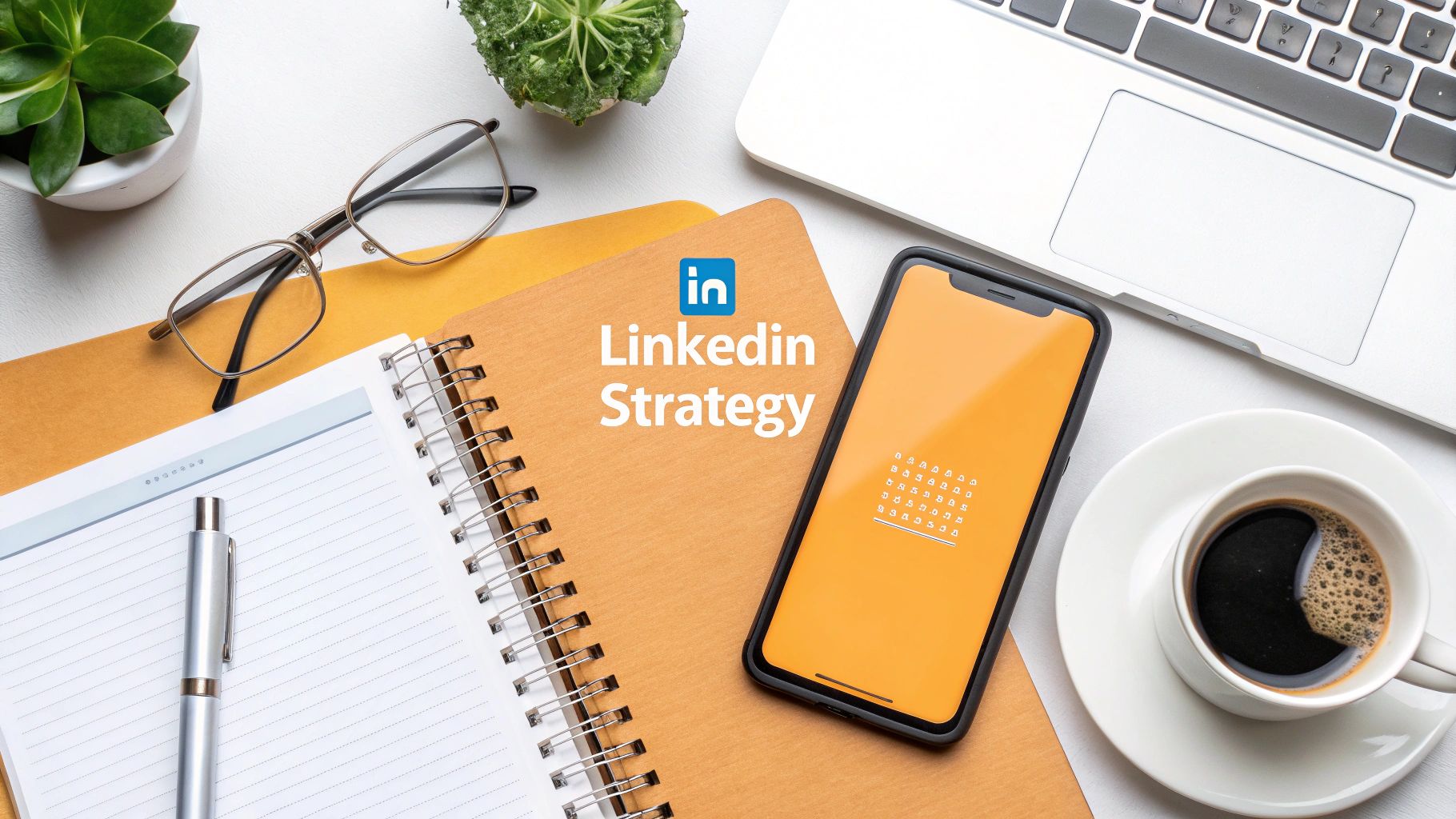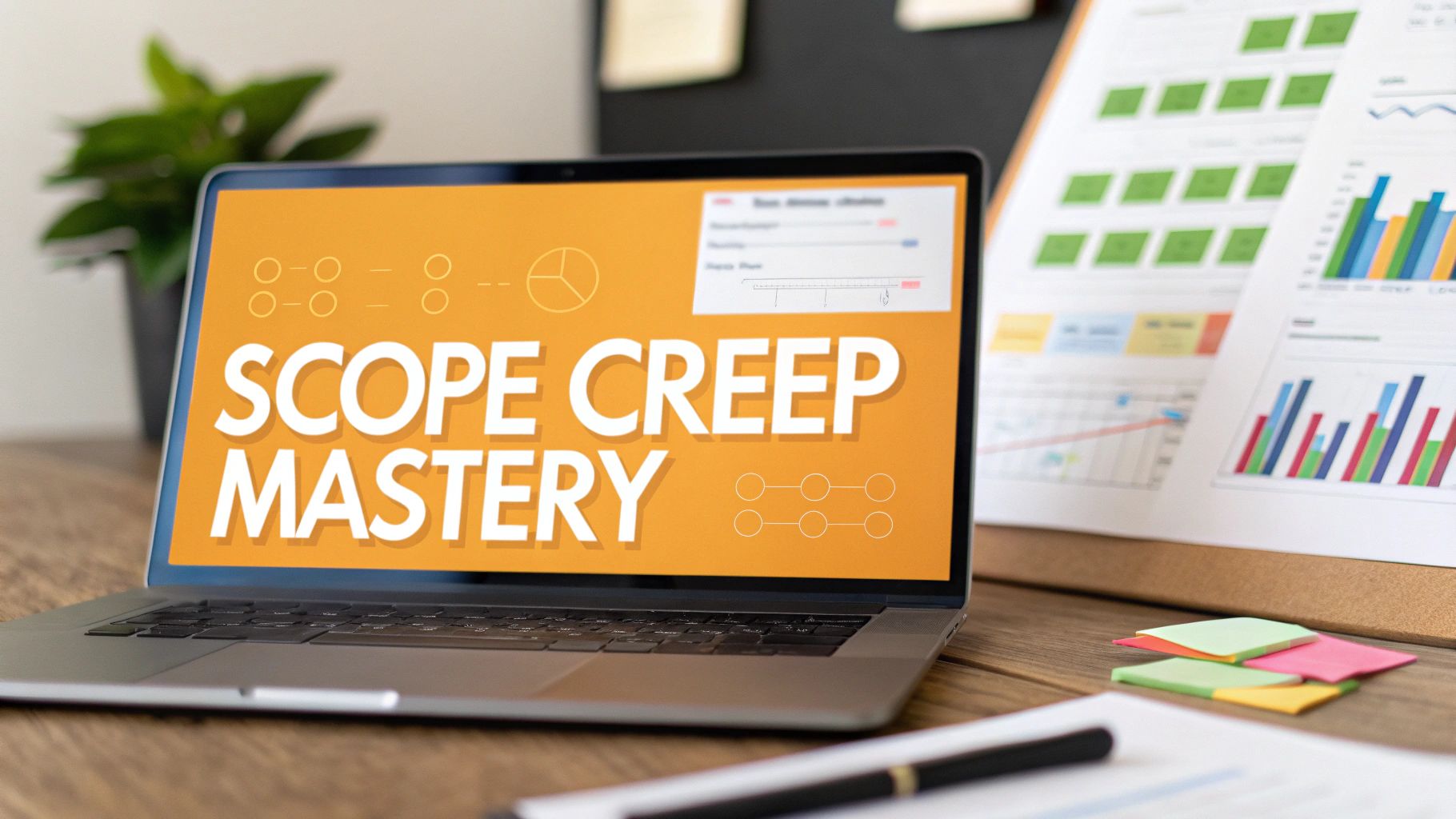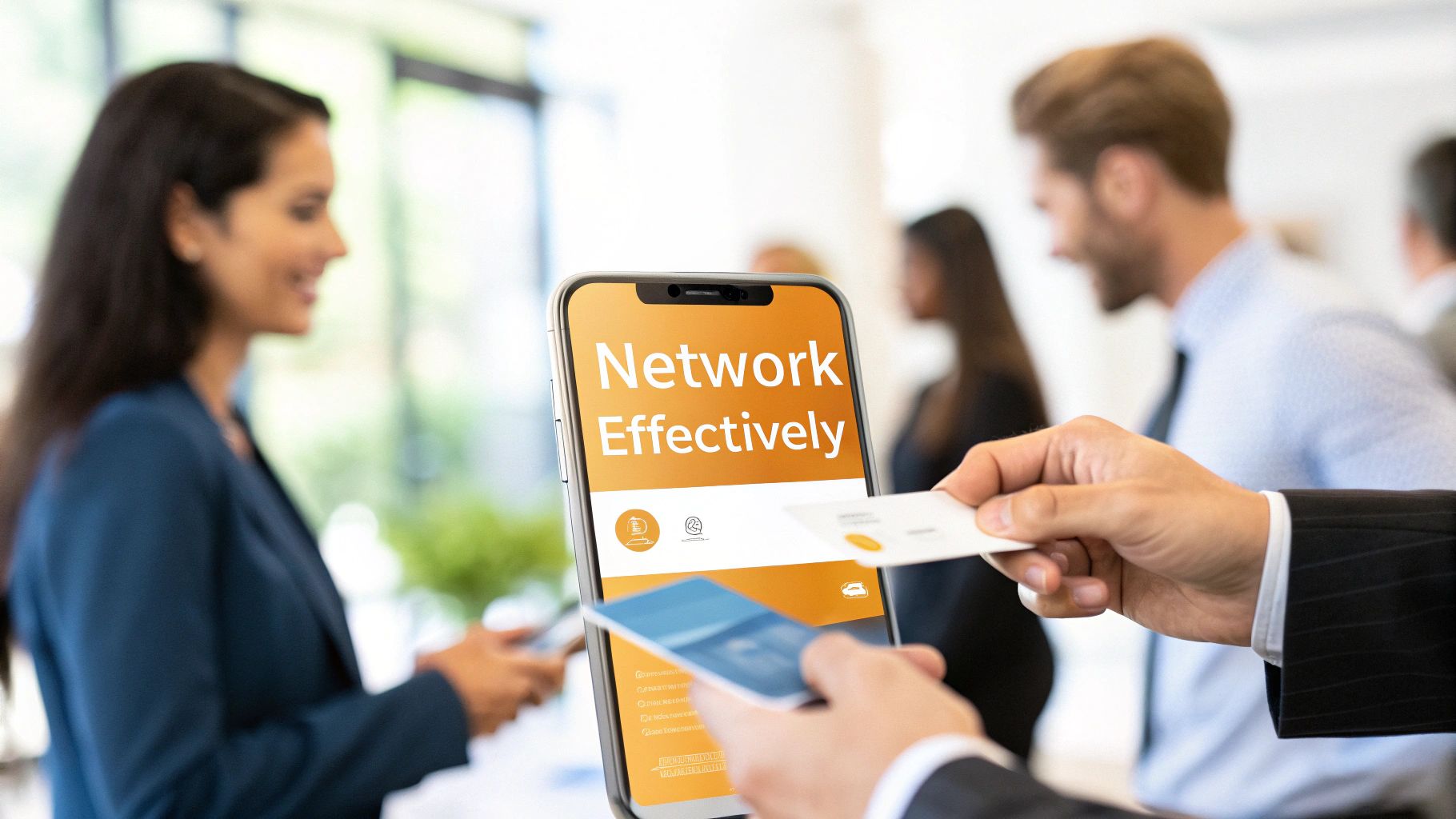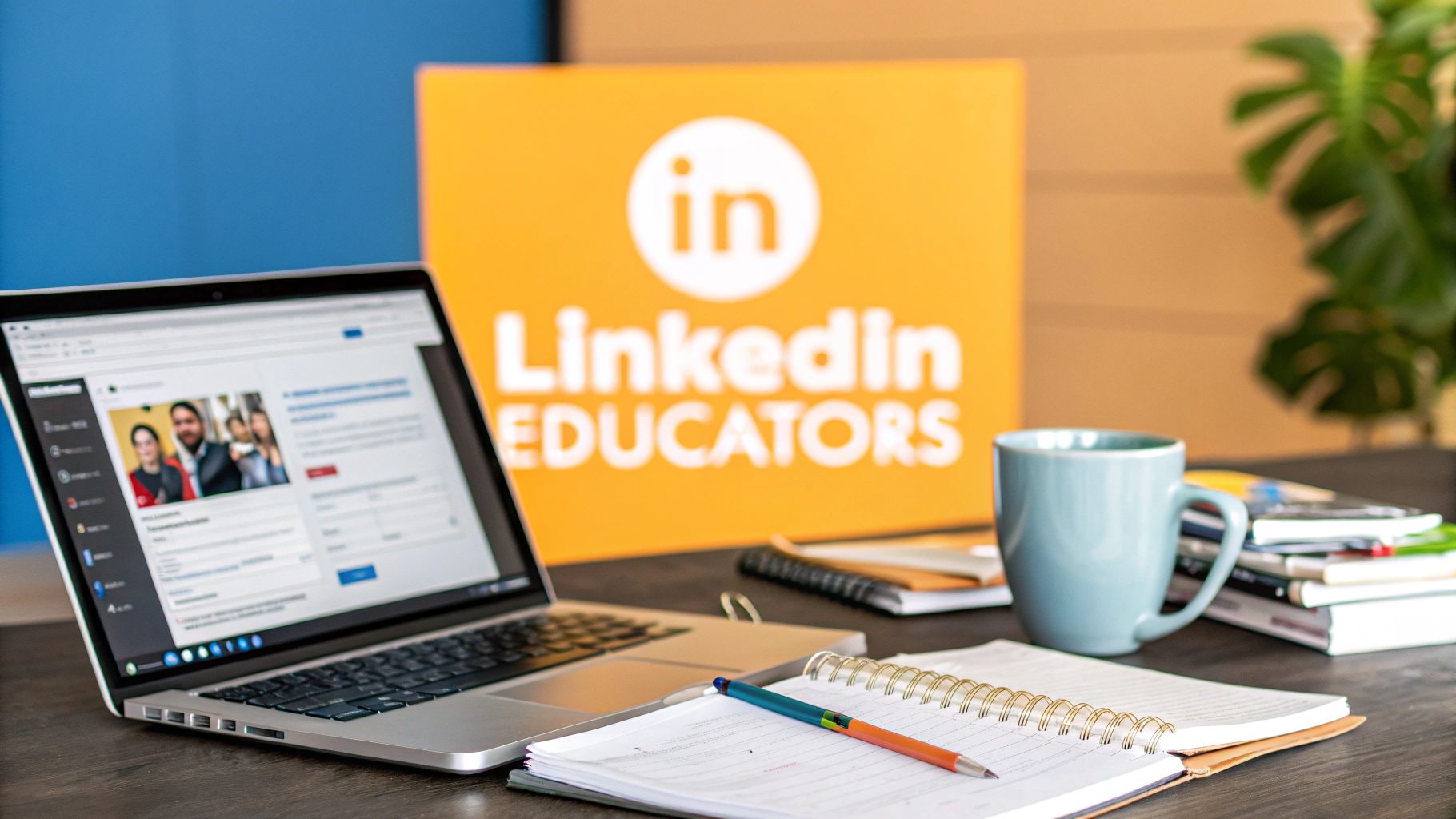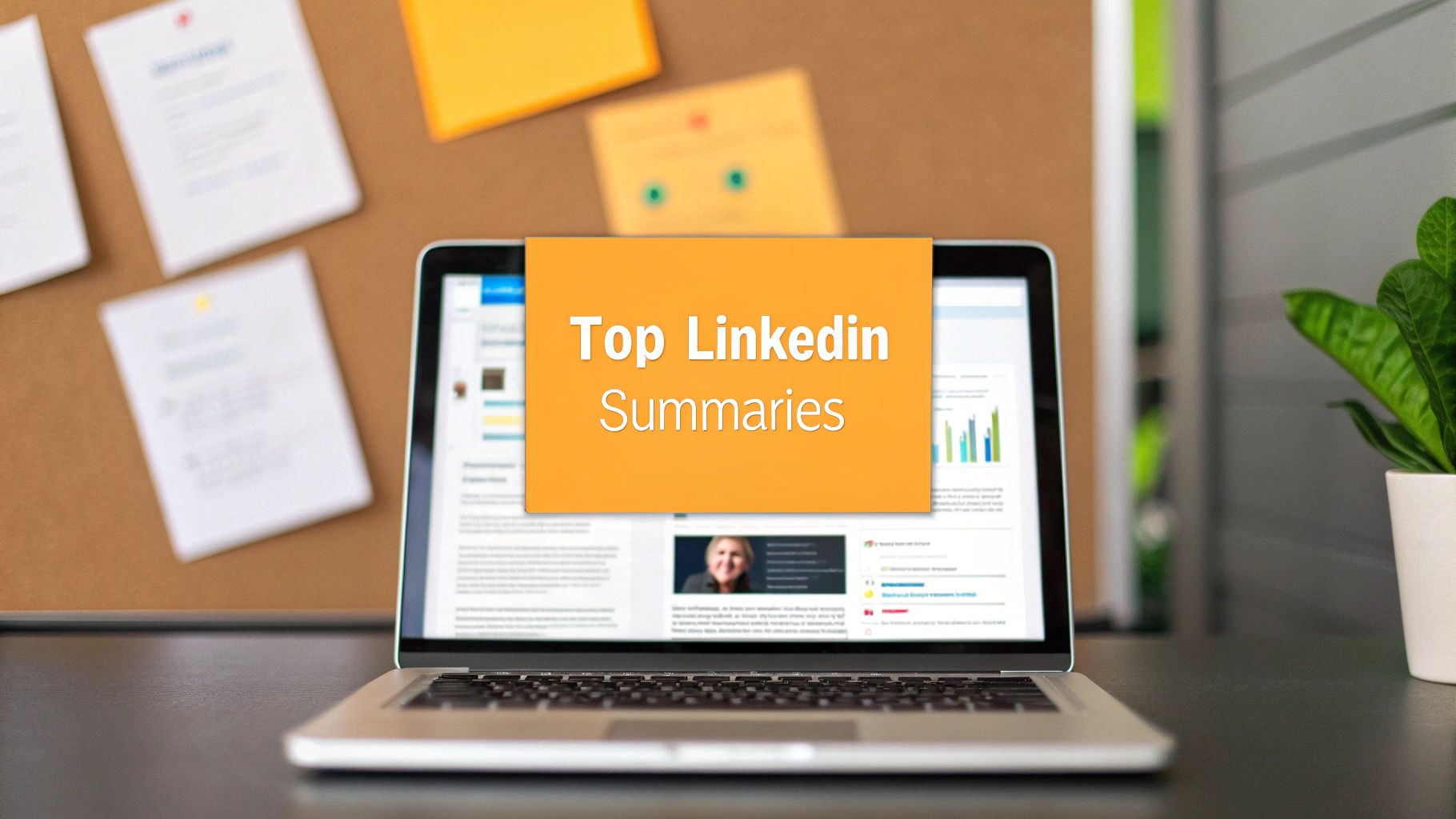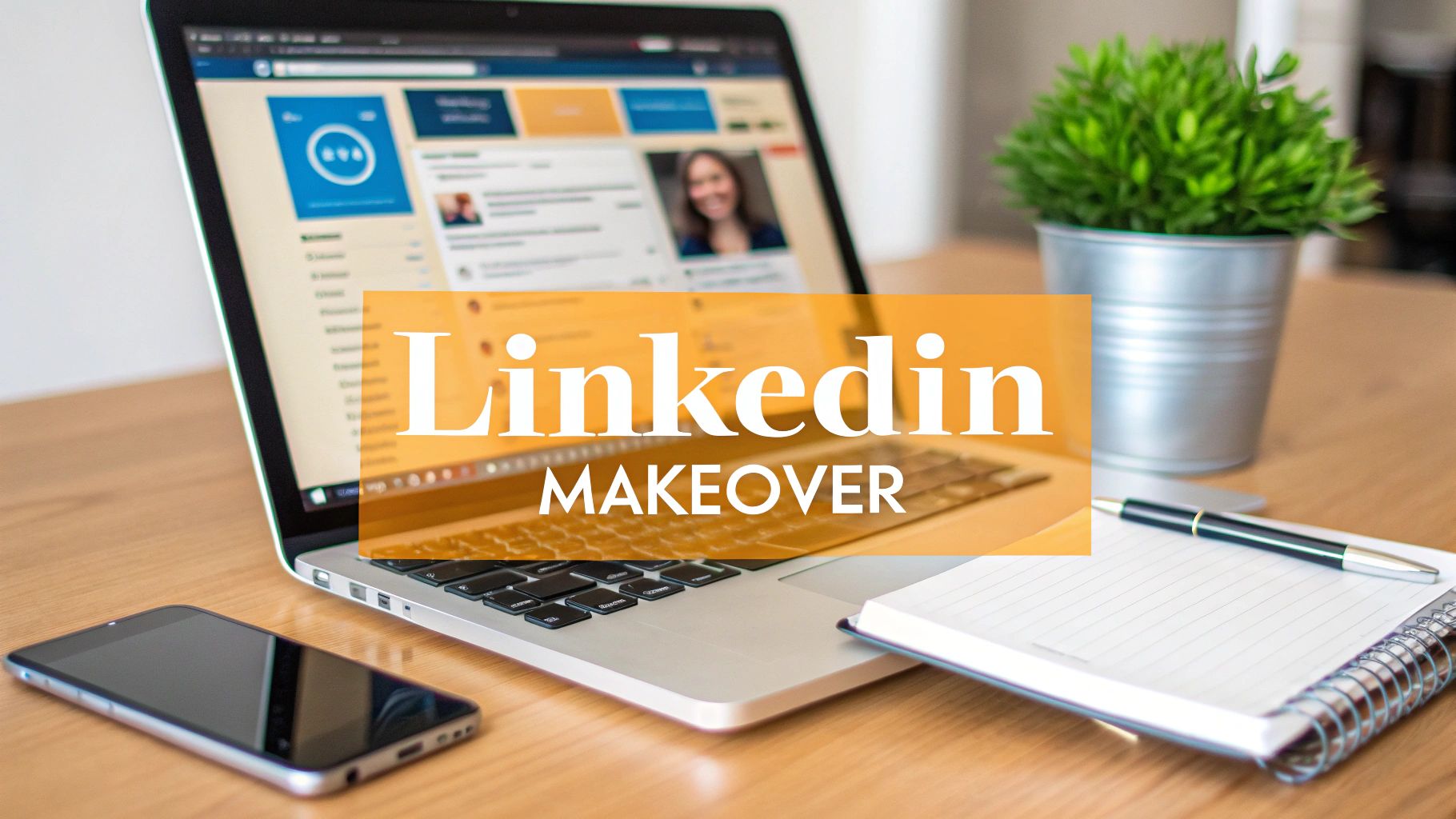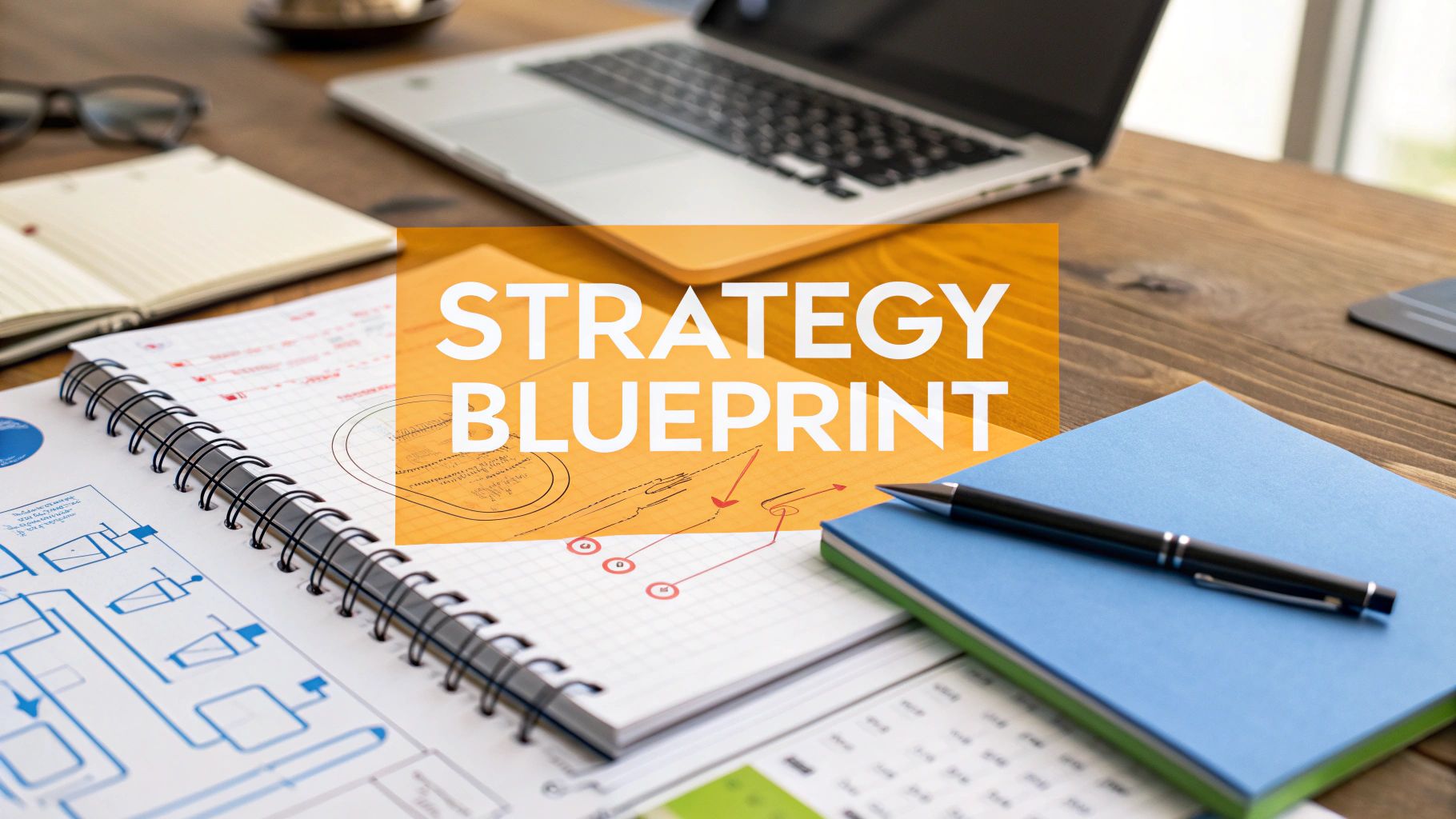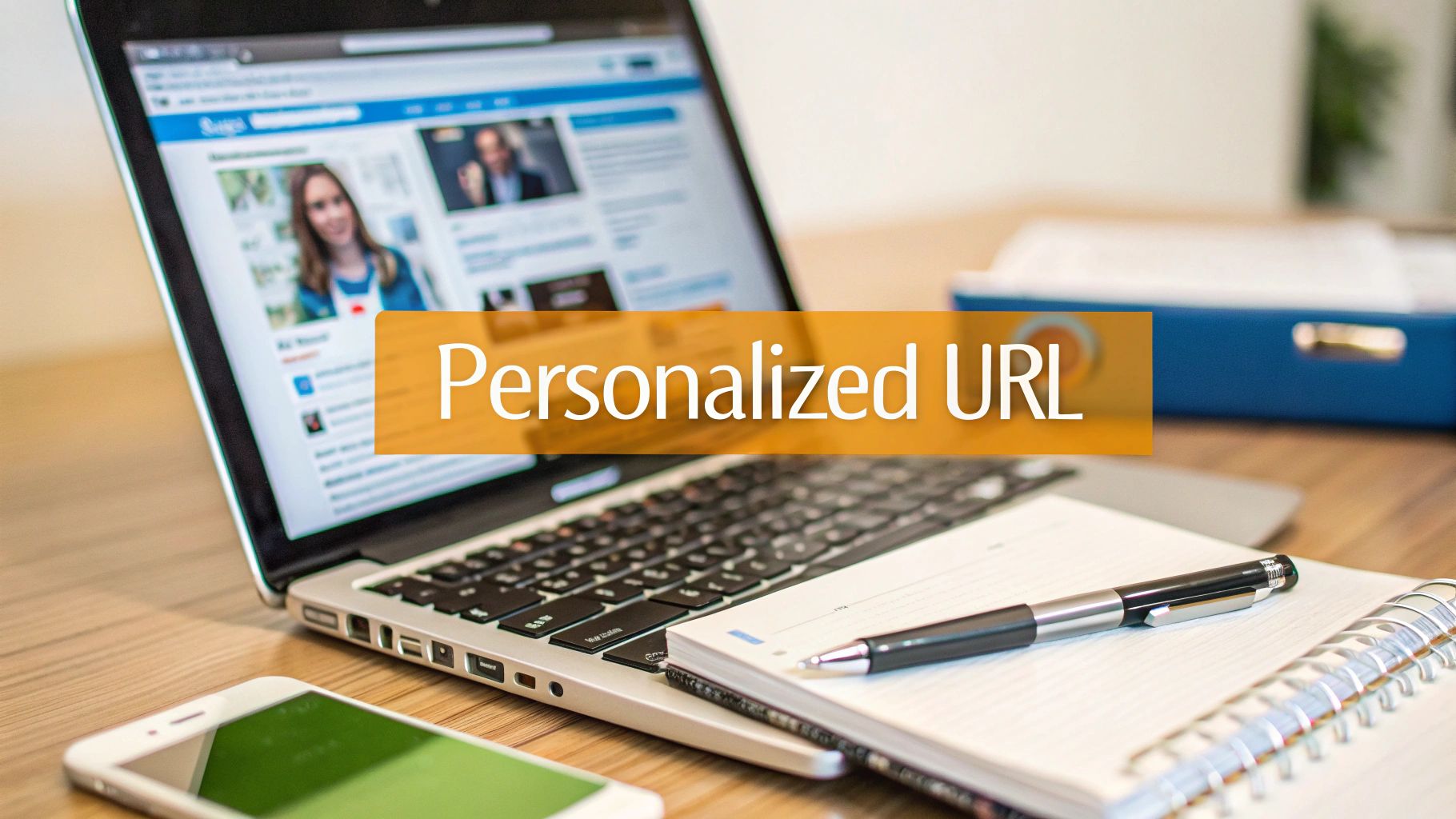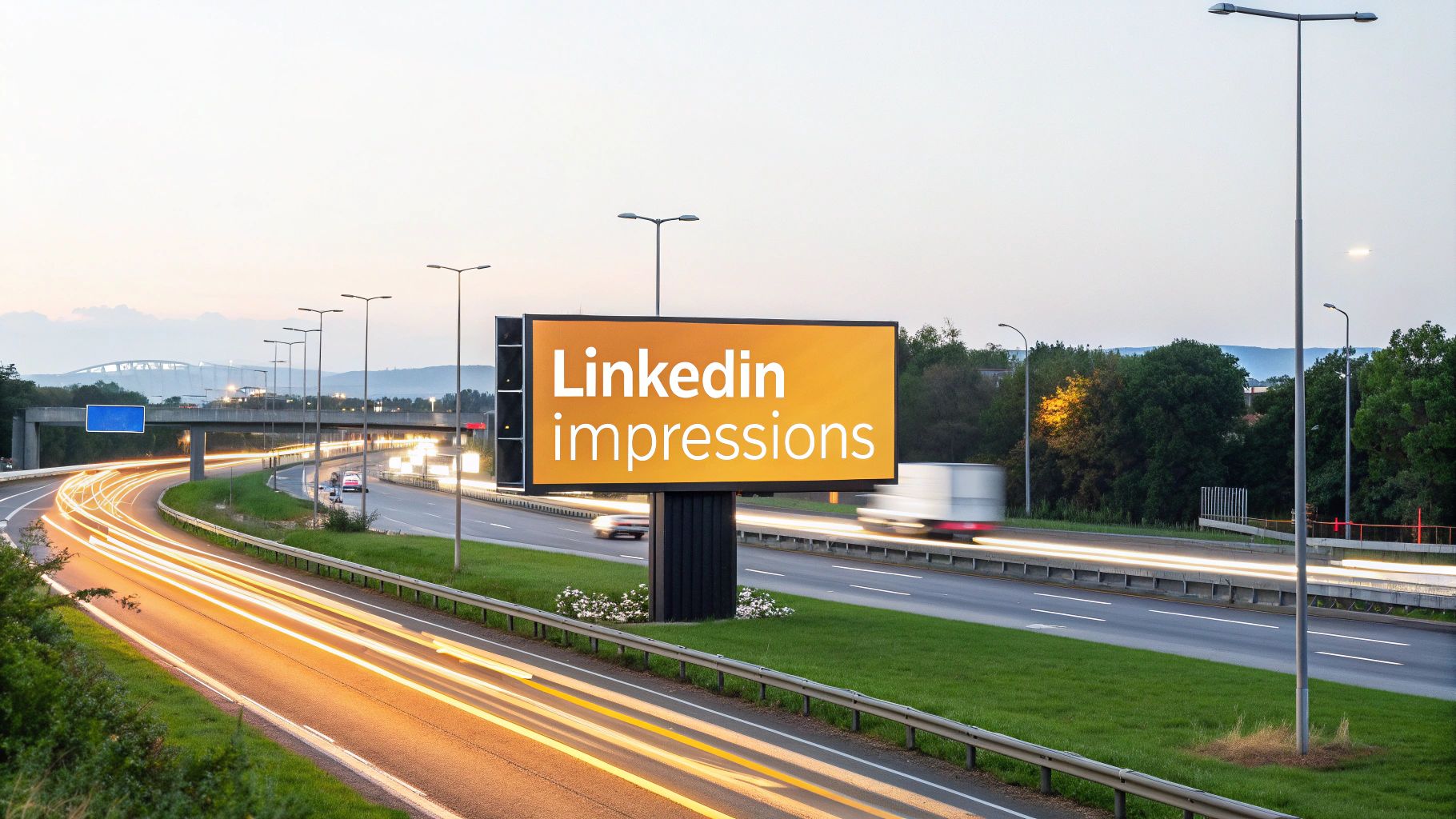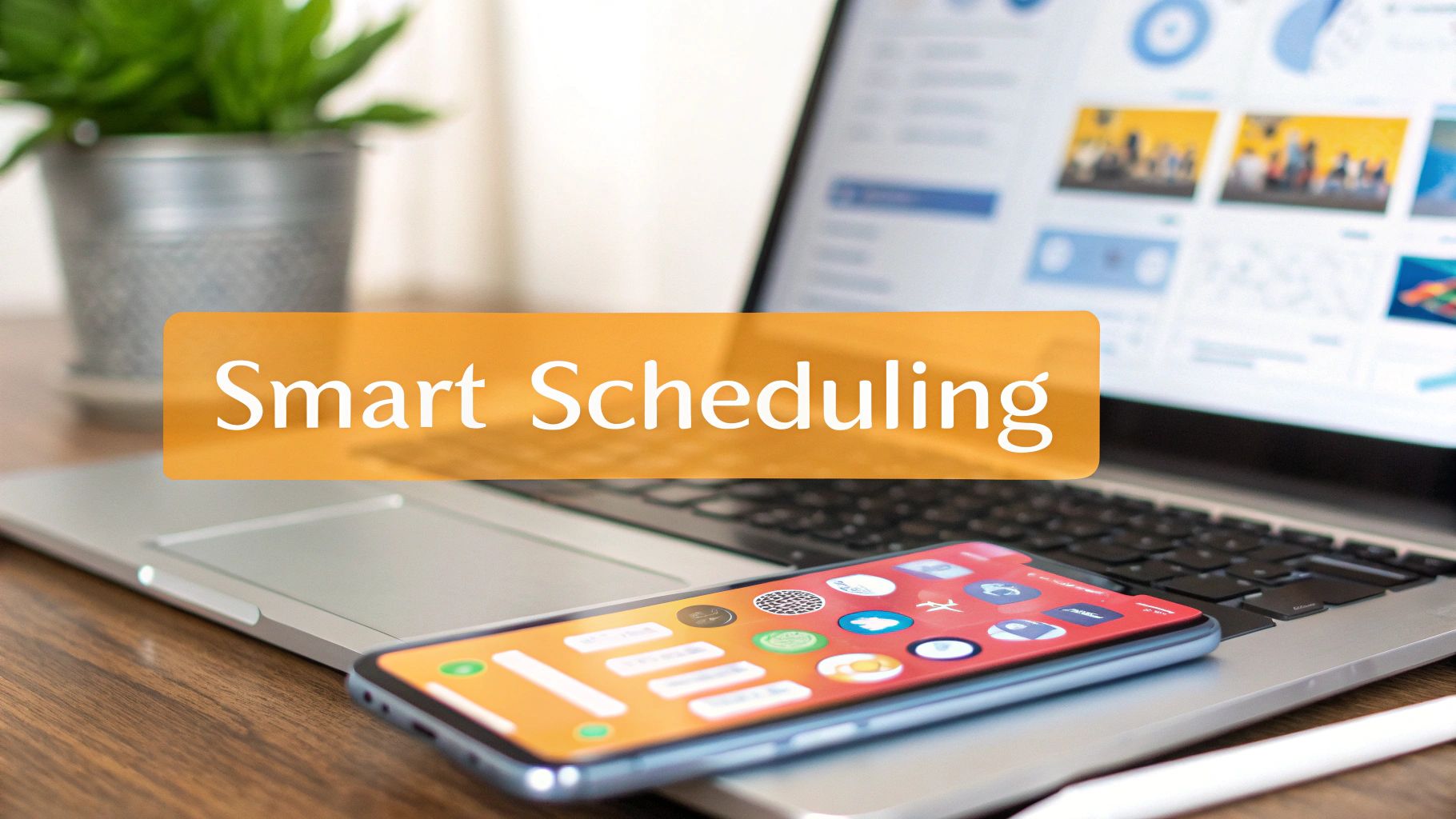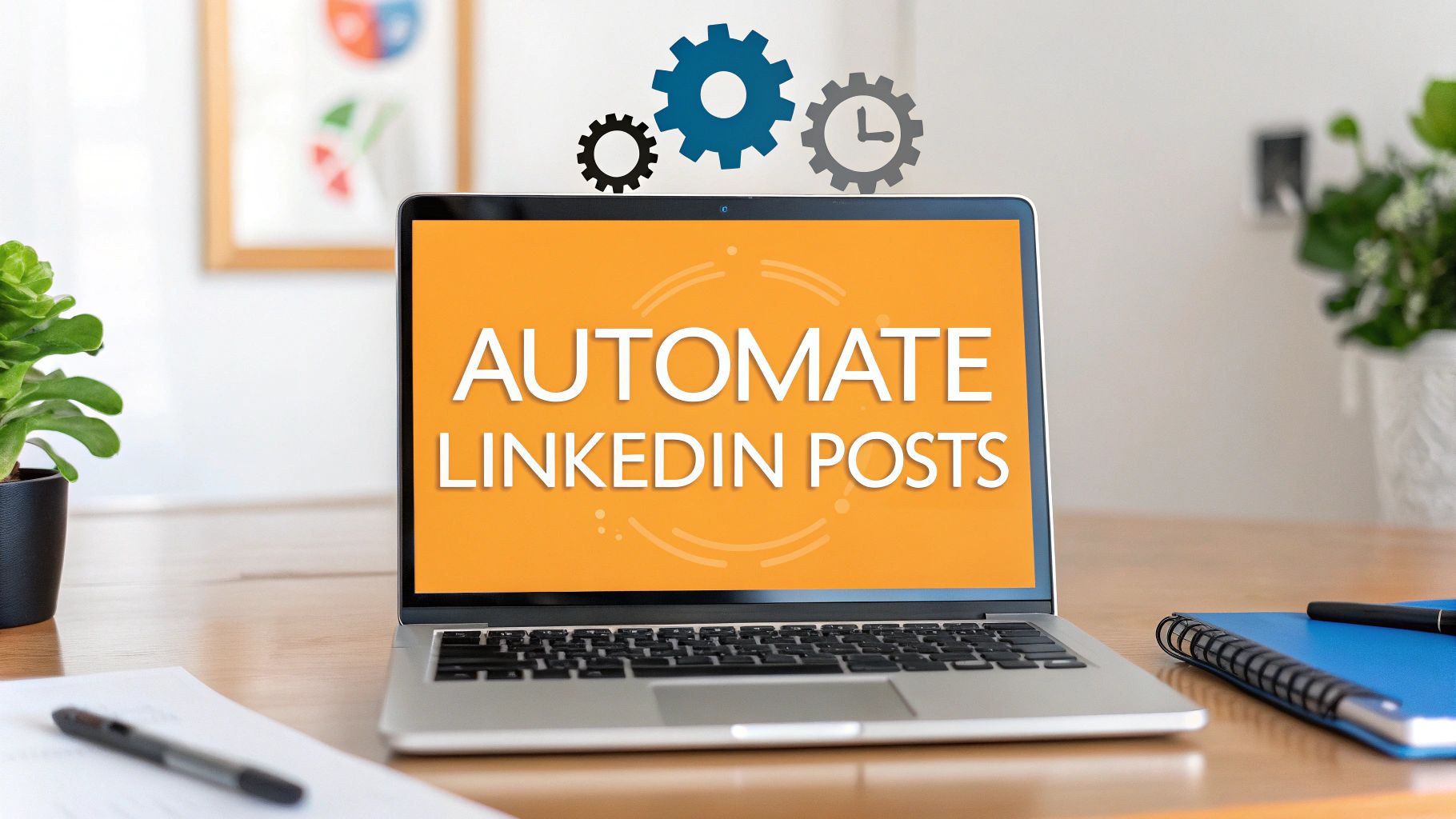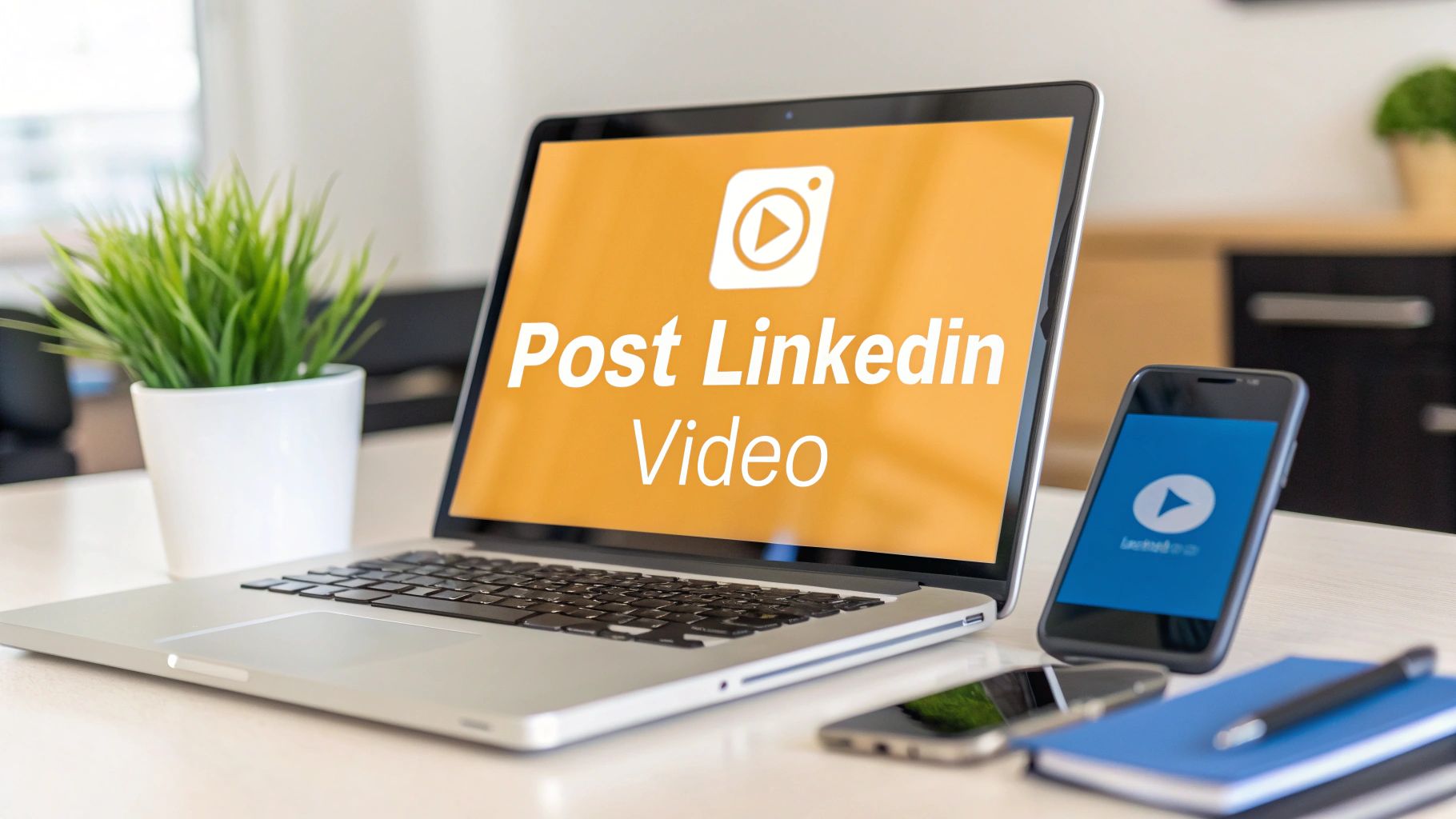Let's be real for a second. When you hear the term "professional networking," what comes to mind? For a lot of people, it's a cringey image of forced small talk, a pocket full of business cards, and a feeling that you're just trying to get something from someone.
But that's not what it's about at all. Not anymore, anyway.
What Is Professional Networking Really About?

At its heart, professional networking is just building genuine connections with people in your industry and beyond. It’s less about collecting contacts and more about creating a community—a support system—that helps everyone involved grow.
Think of it this way: networking is more like tending to a garden than it is like hunting. You don't just throw some seeds on the ground and expect a full harvest the next day. You nurture them. You give them a little water, make sure they get sunlight, and trust that with consistent care, something valuable will grow over time. The goal isn't just to take; it's to contribute.
Moving Beyond Transactional Thinking
The biggest mistake people make is thinking networking has to feel fake or transactional. The moment you start thinking "what can this person do for me?" you've already lost.
Real networking is built on being yourself and having a genuine interest in other people. It’s about having conversations that spark ideas, offer support, and open doors to chances you’d never find on a job board. And it's not just a nice idea—it has real impact. Some studies show that up to 85% of all jobs are filled through connections, which tells you everything you need to know about the power of a strong professional circle.
Your network isn't just a list of contacts on LinkedIn; it's your single most valuable career asset. It functions as your personal board of advisors, your source for industry trends, and your safety net during career transitions.
This modern approach focuses on making it a two-way street. You have to be willing to give as much as you get. It’s often the small, simple acts that build the strongest bonds.
This could mean:
- Sharing a helpful article with someone who you know is interested in that topic.
- Introducing two contacts who you think could really benefit from knowing each other.
- Offering your expertise or a quick bit of advice when you see someone struggling.
To get a clearer picture, let's break down the key parts of networking.
Networking At A Glance
This table sums up the core ideas of modern networking.
| Component | What It Means | Why It Matters |
|---|---|---|
| Relationship Building | Creating genuine, long-term connections. | Builds trust, making people more willing to help you down the road. |
| Mutual Benefit | Focusing on a "give and take" approach. | Establishes you as a valuable, collaborative member of your community. |
| Knowledge Sharing | Exchanging insights, trends, and advice. | Keeps you informed and helps you make smarter career decisions. |
| Opportunity Creation | Uncovering new jobs, projects, or collaborations. | Taps you into the "hidden job market" that isn't publicly advertised. |
Ultimately, when you reframe networking as a long-term investment in relationships rather than a short-term hunt for favors, you build a professional community that's both resilient and supportive. That's the real foundation of a successful and fulfilling career.
The Digital Shift In Building Connections

Not too long ago, "networking" meant stuffy conference rooms and awkward mixers. Today, that’s completely changed. Professional networking has gone digital, and it’s happening all day, every day. Your next big career move could literally be one click away.
Platforms like LinkedIn, X (what we used to call Twitter), and countless niche forums have become the new professional hubs. You don't need a plane ticket to meet an industry leader anymore—you can reach them from your couch with a well-crafted message. This is a massive shift that has completely changed the rules of the game.
Your Digital Footprint Is Your Reputation
Every post you share, comment you leave, or article you like adds to your digital footprint. Think of it as your professional reputation working for you around the clock. It’s a living portfolio that shows people who you are, what you’re good at, and what you’re passionate about.
When you consistently share helpful insights or jump into thoughtful conversations, you're doing more than just scrolling. You’re building trust and establishing yourself as an authority. The numbers don't lie: a massive 65–66% of the global population is on social media, making these platforms a core part of career building. With people jumping between nearly seven different platforms a month, digital networking is now just a part of daily life for billions.
In the digital realm, your network isn't just who you know; it's who knows of you. Your activity creates a trail of expertise that attracts opportunities, often when you least expect it.
This constant visibility lets you build relationships on a scale that was unimaginable just a decade ago. It also means that being consistent is everything.
Turning Clicks Into Connections
So, what does this look like in the real world?
Imagine you’re following a marketing director at a company you'd love to work for. Instead of just hitting "connect" out of the blue, you see they’ve posted an article. You leave a comment that adds a unique perspective, not just a generic "great post!"
They reply. A short, professional conversation starts right there in the comments. A couple of weeks later, you find an interesting industry report and share it, tagging them and mentioning how their article got you thinking. Just like that, you’re on their radar as someone who's switched on and engaged.
This is what modern networking is all about. It’s about using these small digital touchpoints to build real rapport over time. Each interaction is another brick in the foundation of a strong professional relationship. For more practical ideas, check out our guide on how to get more connections on LinkedIn.
Why Your Network Is A Career Superpower
Forget what you think you know about networking. It's not just about schmoozing to find your next job—it’s the single most powerful tool for building a successful, stable career. Think of it as your personal board of directors, always there to offer support, insights, and opportunities, often when you least expect them.
The real power lies in what’s often called the hidden job market. These are the roles that get filled through a referral or an internal tap on the shoulder long before they ever see the light of day on a job board. If you're not connected, you're simply not in the conversation for these opportunities.
The numbers here are staggering. An incredible 85% of all jobs are filled through personal and professional connections. What's more, a massive 70% of jobs are never even advertised publicly. This means that for the vast majority of roles, who you know is the only way to get your foot in the door. It’s not just about finding a job, either—80% of professionals agree that networking is crucial for climbing the ladder. If you want to see the data for yourself, you can explore the full networking statistics on novoresume.com.
Your Source for Real-Time Insights
A good network is like having your own private intelligence agency. Forget polished corporate press releases—through genuine conversations with your peers, you get the real, unfiltered story of what’s happening in your industry.
These connections are your inside track on things like:
- Emerging Trends: You'll hear about the next big thing before it becomes the last big thing.
- Company Culture: Get the honest truth about what it's really like to work somewhere, beyond the glossy careers page.
- Salary Benchmarks: Find out what people in roles similar to yours are actually making so you can know your worth.
This kind of inside scoop allows you to make smarter, more strategic moves in your career. You’re no longer guessing; you have a direct line to people on the ground.
A strong network transforms you from a passive job seeker into an active career architect. It gives you the power to create your own opportunities rather than waiting for them to appear.
A Safety Net and a Springboard
Beyond information, your network provides something even more fundamental: resilience. When you hit a rough patch—a layoff, a dead-end project, or just a crisis of confidence—your network is the support system that catches you. They’re the ones who offer advice, make an introduction, or just listen.
But it’s not just a safety net; it’s also a springboard. Your network is where unexpected collaborations, speaking gigs, and mentorship opportunities come from. These are the relationships that open doors you didn’t even know existed.
When you start treating networking as a long-term investment in your growth, it stops feeling like a chore. You’re not just collecting contacts; you’re building the foundation for your entire professional life. For a deeper dive into making these connections stick, check out our guide on essential relationship-building skills.
Finding Your Personal Networking Style
The word "networking" often conjures up images of a stuffy conference room, a stack of business cards, and a whole lot of forced small talk. It's an intimidating picture, right? But here’s the secret: real, effective networking isn't about shoehorning yourself into that one-size-fits-all mold.
It’s about finding a rhythm that feels authentic to you and lines up with what you're trying to achieve right now. There is no single "right" way to build connections. The best style is simply the one you'll actually stick with, making the whole process feel less like a chore and more like a natural part of your professional life.
The Strategic Networker
Think of strategic networking as networking with a mission. This is the approach you take when you have a very specific, tangible goal in mind. You aren't just collecting contacts; you're building relationships with a clear purpose.
For example, a strategic networker might:
- Pinpoint and connect with hiring managers at three of their dream companies.
- Track down experts in a particular software to get help with a tricky work problem.
- Set up informational interviews with people in an industry they want to break into.
This style is all about focus and efficiency. It’s perfect for hitting short-term targets because you know exactly what you want and who can help you get there.
The real key to strategic networking is doing your homework. You have to research the right people and have a clear, value-focused reason for reaching out. It shows you respect their time and aren't just firing off random requests.
This infographic does a great job of breaking down the core benefits a strong network provides, regardless of your personal style.
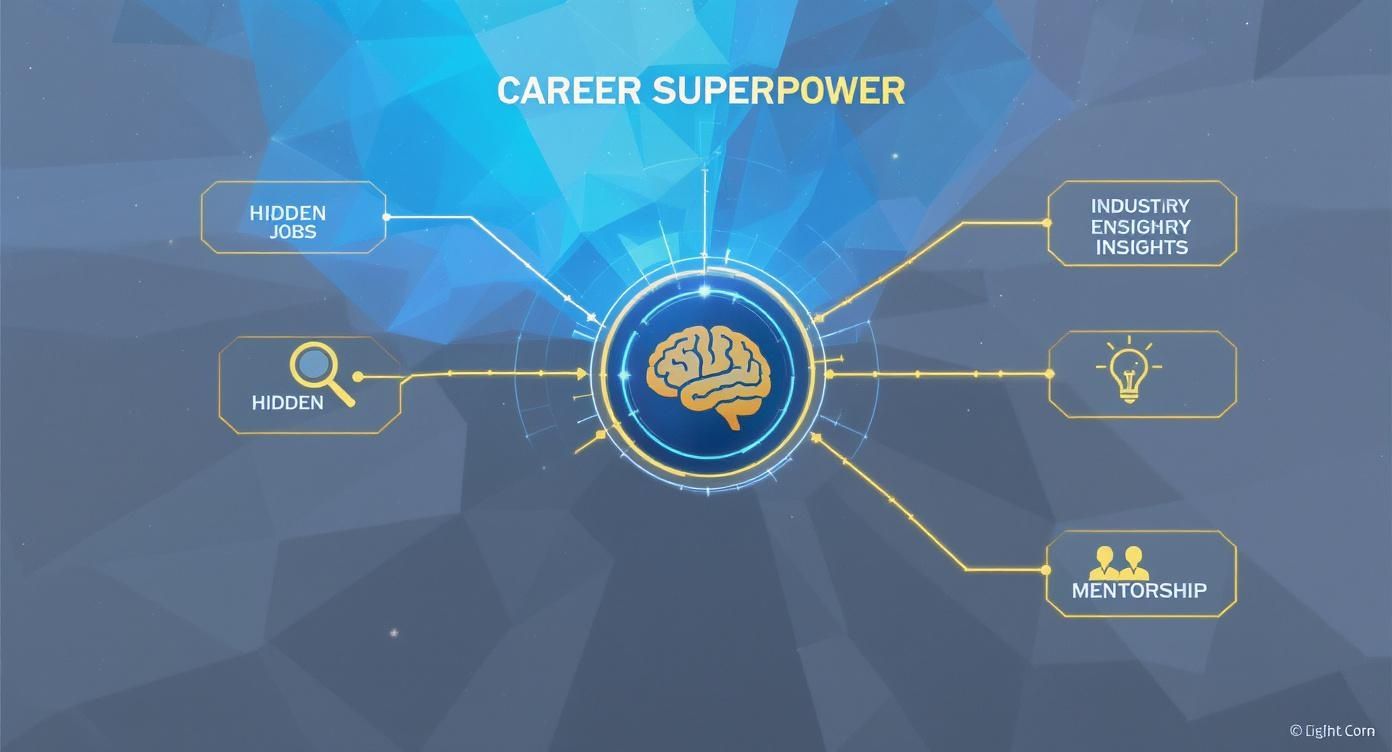
As you can see, networking is your direct line to unlisted job opportunities, insider industry knowledge, and invaluable mentorship.
Relational vs. Opportunistic Networking
While being strategic is incredibly powerful, it's not the only way to play the game. Relational networking is the long game. It's about building genuine, lasting connections without expecting anything in return right away. Think of it as planting seeds for the future. You're focused on shared interests and are always looking for ways to help others first.
Then there’s opportunistic networking. This is all about being present and staying open to the connections that pop up unexpectedly. It's striking up a conversation with the person next to you in line for coffee or jumping into a fascinating discussion you stumble upon on LinkedIn. A great LinkedIn profile headline can actually make you a magnet for these kinds of spontaneous interactions.
Not sure which approach to take? This quick table can help you match the networking style to your specific goal.
Which Networking Style Fits Your Goal
| Networking Type | Primary Goal | Best For... | Example Action |
|---|---|---|---|
| Strategic | Achieving a specific, short-term objective. | Job hunting, solving a specific problem, career transitions. | Researching and contacting a key decision-maker at a target company. |
| Relational | Building long-term, authentic relationships. | Career-long support, mentorship, building a strong reputation. | Regularly engaging with a mentor's content and offering helpful insights. |
| Opportunistic | Seizing spontaneous connection opportunities. | Expanding your network unexpectedly, discovering new ideas. | Chatting with a fellow attendee at a workshop or industry event. |
Ultimately, the most successful professionals I know don't just stick to one style. They masterfully blend all three. They get strategic when they have a clear goal, they're relational in their everyday interactions, and they're always ready to be opportunistic when a chance appears. This balanced approach is what builds a truly robust and powerful network over time.
Practical Networking Strategies That Actually Work
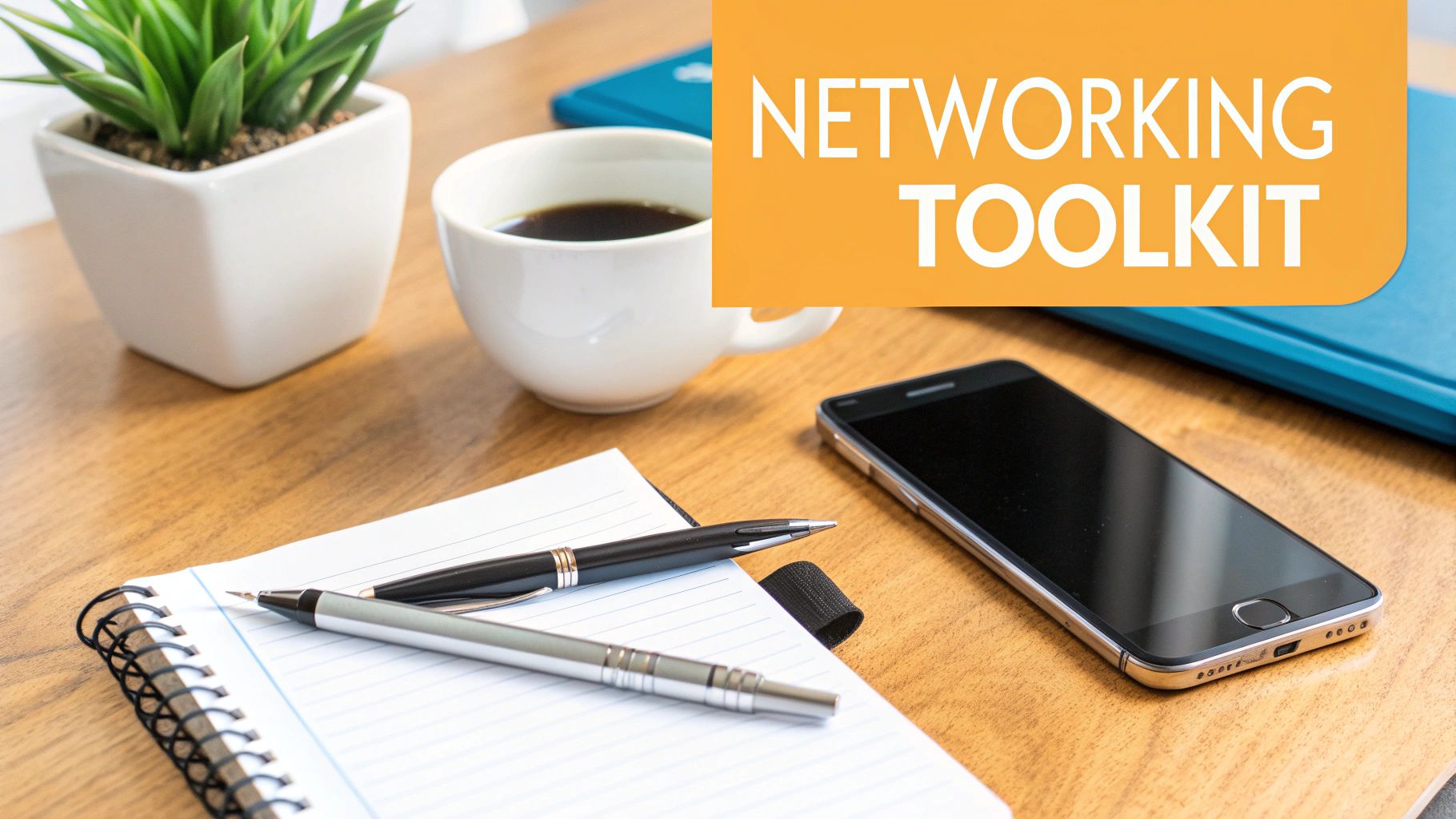
Alright, enough with the theory. Let's get down to what actually works. Building a great professional network isn't about some secret formula; it's about a few key actions you can start taking right now. Forget the fluff—these are the real-deal strategies that create genuine relationships, not just a bigger number next to your LinkedIn connection count.
The most important rule in all of networking is simple: give before you get. Think about it. People are way more likely to help you out if you've already offered them something valuable, with no strings attached.
This doesn't mean you have to do something huge. It can be as simple as sharing an article you know they'd like, leaving a thoughtful comment on their post, or connecting two people you know who could help each other. Shifting your mindset from "what can I get?" to "what can I give?" changes everything. It turns networking from a self-serving chore into a genuinely rewarding way to build a community.
Master The Art Of The Connection Request
That generic, default "I'd like to add you to my professional network" message? It’s the digital version of a limp, awkward handshake. It's forgettable, lazy, and screams "I don't really care who you are." A personalized request, on the other hand, immediately shows you’ve put in a little effort and have a real reason for reaching out.
Here’s a simple, can't-miss formula for a request that actually gets accepted:
- Start with something specific. Mention a mutual connection, a recent post of theirs you enjoyed, or maybe a talk they gave that you watched online.
- Explain your "why." Tell them why you want to connect with them in particular. Keep it short and to the point.
- Keep the closing simple. No pressure, just a light and professional sign-off.
For example: "Hi Sarah, I saw your comment on John Doe's post about AI in marketing—your point about ethical data use was brilliant. I'm always looking to connect with other leaders in the marketing tech space. Would be great to connect here."
See the difference? It's personal, specific, and genuine.
How To Ask For An Informational Interview
Informational interviews are networking gold. They are low-pressure chats where you get to pick someone's brain, soak up their experience, and get real-world advice. The trick is to ask in a way that respects their time.
An informational interview isn't a secret job interview. You have to frame it as a chance to learn from their experience, not as a backdoor way to ask for a job. This approach takes the pressure off and makes it so much easier for them to say "yes."
When you reach out, be direct but polite. Say who you are, why you admire their work, and that you're just looking for some advice. Ask for a brief 15-20 minute chat and make it clear you can work around their schedule. This small gesture shows you know they're busy and that you value their time.
And always, always send a thank-you note afterward. Don't just say "thanks!"—mention a specific piece of advice they gave you. To really elevate your game, check out these proven tips for effective networking. They drive home the point that the best networking always starts with a real, human-to-human connection.
Common Networking Mistakes To Avoid
Knowing the right moves is half the battle, but knowing what not to do can save you from sinking your professional reputation before you even leave the shore. Great networking is a subtle art, and a few common blunders can erase all your hard work in an instant.
The biggest mistake I see? Treating people like a transaction. This is the person who only pops up when they need something—a job referral, a quick favor, an introduction. It makes people feel used and immediately shows you have no interest in building a real, two-way street.
Another classic screw-up is the immediate cold pitch. You know the one: you connect with someone on LinkedIn, and your first message is an ask for a job or a sales pitch. It’s the digital version of walking up to a stranger and asking for a loan. It's awkward, unprofessional, and almost guaranteed to fail.
The Collector vs. The Ghoster
These bad habits often lead to two networking archetypes we’ve all met. Spotting them is the first step to making sure you don't become one yourself.
"The Collector" is that person bragging about their 5,000+ connections but not having a real relationship with any of them. They are all about quantity over quality, blasting out generic connection requests to anyone and everyone. Their network is a mile wide and an inch deep, which means it offers almost no real value because there’s no trust or rapport.
A huge network is useless if it's not nurtured. The goal isn't to have the most connections; it's to have the strongest ones. Real influence comes from trust, not just a big number.
"The Ghoster" is just as bad. This person is your best friend right up until they get what they need. Once they have that introduction or the advice they were after, poof—they vanish. No follow-up, no thank you, nothing. They just burned a bridge they might desperately need to cross again someday.
It’s pretty simple to avoid these traps:
- Always lead with value. Before you ask for a thing, think about what you can offer them first.
- Personalize your messages. Show you took 30 seconds to learn something about them before clicking "connect."
- Follow up. A simple "thank you" is powerful and keeps the door open for the future.
By steering clear of these all-too-common mistakes, you'll stand out as a thoughtful, genuine professional—the kind of person everyone wants in their network.
Answering Your Top Networking Questions
Even with a solid game plan, a few nagging questions can make you hesitate. Let's clear up some of the most common worries people have about networking, so you can move forward with confidence.
How Do I Start Networking If I'm An Introvert?
Forget the crowded rooms and schmoozing. Your comfort zone is online, where you have time to think before you type. Start there.
Instead of trying to connect with everyone, focus on quality. Send a personalized message to one or two people about a shared interest. Or, leave a genuinely thoughtful comment on someone's post—not just "great post!" but something that adds to the conversation.
One-on-one interactions are an introvert's superpower. These conversations are often more comfortable and lead to much stronger connections than trying to shout over the noise at a big event.
Networking for introverts isn't about faking it 'til you make it as an extrovert. It's about playing to your strengths: being a great listener and having meaningful, one-on-one conversations.
What's The Best Way To Follow Up?
The key is to be prompt and personal. Within 24 hours of your chat, send a quick LinkedIn connection request or a short email. The magic trick? Reference something specific you talked about. It instantly jogs their memory and shows you were actually paying attention.
A great follow-up gives, it doesn't take. Share an article you think they'd find interesting, offer a quick insight on the topic you discussed, or simply thank them for their time. The goal is to keep the conversation going, not to immediately ask for a favor.
How Often Should I Be Networking?
Think of it less like a frantic sprint and more like a casual stroll. It’s a habit, not a campaign.
Set aside just 15-20 minutes a week to tend to your network. That's all it takes. You could use that time to comment on a few posts, send a "thinking of you" message to an old colleague, or congratulate someone on a new role. A little consistency goes a long way and is far more effective than trying to do everything at once and then burning out.
Ready to build your personal brand without the hassle? RedactAI helps you create engaging LinkedIn posts in minutes, so you can focus on building relationships while your content does the work. Start for free on RedactAI.io and see the difference.






